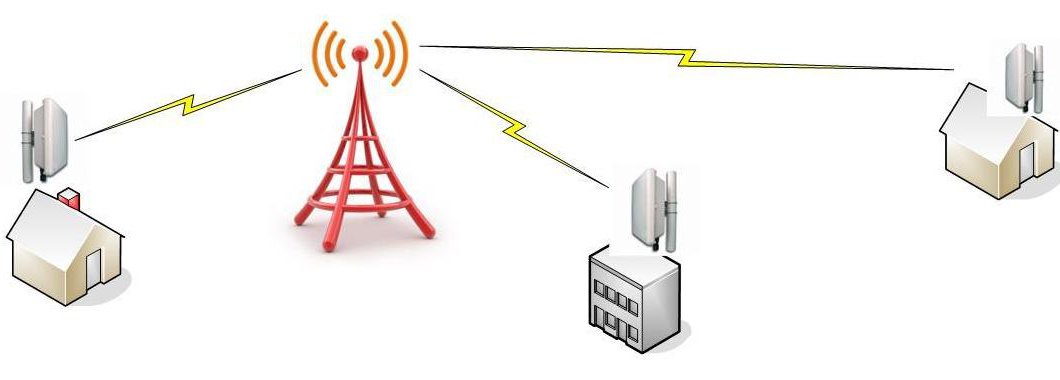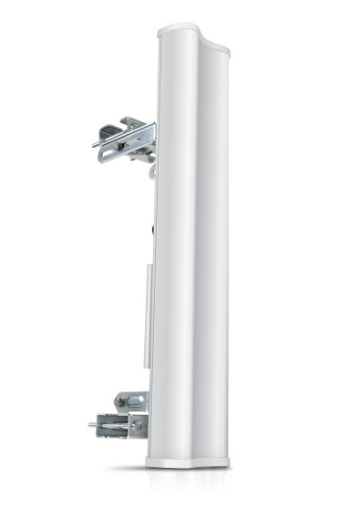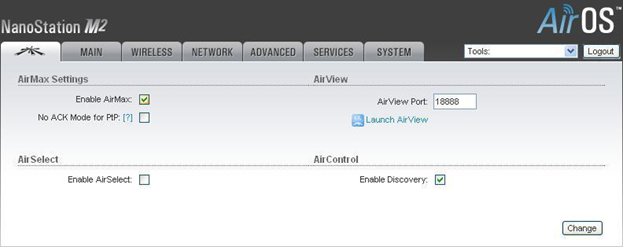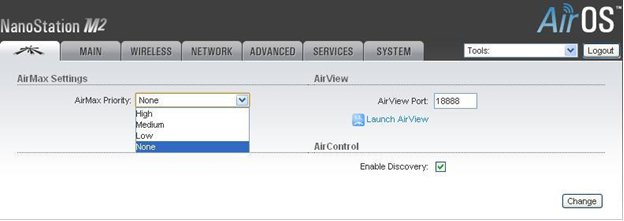Polling in Ubiquiti Networks wireless equipment
Hello, dear residents of the Network. Today we will talk about pollinge - one of the main technologies for building normal wireless networks.
You all know Wi-Fi and have repeatedly come across it. All good technology, and smart (up to 300 Mbit / s claim) and cheap. But for some reason, this wonderful technology is not used by operators to build urban networks. Probably that prevents them, something our favorite Wi-Fi (or rather the group of standards IEEE 802.11 a / b / g / n) - can not.
The algorithm for communicating devices according to 802.11 looks like this:
Before transmitting something, the Wi-Fi subscriber listens to the air - is it busy? If the broadcast is free - the subscriber starts the transmission. And while he is transmitting, the other subscribers are waiting. This is called CSMA / CA (carrier sense multiply access with collision avoidance, carrier access multiple collision avoidance). It seems the technology is beautiful and no collisions can happen. And this is so, as long as all subscribers of the same base “hear” each other. On the office and home Wi-Fi networks, this is exactly the case. But as soon as we start building a network outside the premises, and our subscribers are not located a few meters away, but kilometers away from the base, everything changes. For long distance operation, we use directional antennas.

')
And this means that the subscriber has no idea whether his neighbor is transmitting or not, he hears only the base. But is the base free or is it receiving data from another subscriber now? He does not know. And the collision avoidance mechanism stops working. What to do?
The only normal way out of this situation is hard arbitration from the base. That is, it is up to the base to decide which of the subscribers should transmit now. So polling appeared.
Polling, he is a non-collision access, he is also a marker access. It has been used in wireless access networks since the 1990s. Unlike Wi-Fi, it is not standardized, that is, each manufacturer invents and writes its own version, and the hardware of different vendors with each other does not work in the polling mode.
The main advantages of polling:
Of course, there are disadvantages:
Now let's look at the polling implementation of the AirMAX series from Ubiquiti Networks . If anyone knows, Ubiquiti is a fairly young American company with a creative and open-minded look at the market. And well versed in the intricacies of the wireless world, "hardware" and software for it. They started with the production of radio modules, but soon surprised the world by releasing an outdoor Wi-Fi CPE for $ 100. Five times cheaper than the cheapest all-weather subscriber at the time. And blew up the market. Last year, they again surprised everyone by releasing a new generation not only with 802.11n support, but also with their own polling system, which they called AirMAX. And hacked carrier market. All for the same reason - good universal glands for some pennies. In general, I like them, well done guys. And the glands themselves are very beautiful:

Here is a subscriber with an antenna. And two 100Mbps Ethernet ports with PoE out, speeds up to 150 Mbps and an indicator for fine tuning to the base. And this piece of hardware can also be a base, since the built-in antenna (55 x 30 degrees) allows you to build sectors.
Or base with sector antenna:

You see the antenna, the base station is hidden behind it, it is very compact.
So, how does polling work in AirMAX?
When you turn on AirMAX, the base station distributes clients certain time / data slots, with the result that the data transfer by the client will occur regardless of the busy radio environment.
Also, a proprietary QoS scheduler is involved in AirMAX, which automatically allocates VoIP / Video packets in traffic and gives them the highest priority.
AirMAX implements a dual TDMA system by adding priority to a specific client. The higher the priority level, the more slots will be given to it. In order not to worsen the situation on the base in the presence of a “bad client” - its AirMAX priority should be minimal in the existing priority configuration.
Setting up a polling in AirMAX is very simple:
At the base station, tick the “Enable AirMax” checkbox:

To enable polling on the subscriber device, you must select the client priority level:

And that's all. Very simple. Although there are subtleties. For example, the “far” subscriber is better to assign a minimum priority so that he does not “squander” the base while working on low modulation.
And in the next article we will discuss in more detail the functionality of the AirOS and the intricacies of customization.
You all know Wi-Fi and have repeatedly come across it. All good technology, and smart (up to 300 Mbit / s claim) and cheap. But for some reason, this wonderful technology is not used by operators to build urban networks. Probably that prevents them, something our favorite Wi-Fi (or rather the group of standards IEEE 802.11 a / b / g / n) - can not.
The algorithm for communicating devices according to 802.11 looks like this:
Before transmitting something, the Wi-Fi subscriber listens to the air - is it busy? If the broadcast is free - the subscriber starts the transmission. And while he is transmitting, the other subscribers are waiting. This is called CSMA / CA (carrier sense multiply access with collision avoidance, carrier access multiple collision avoidance). It seems the technology is beautiful and no collisions can happen. And this is so, as long as all subscribers of the same base “hear” each other. On the office and home Wi-Fi networks, this is exactly the case. But as soon as we start building a network outside the premises, and our subscribers are not located a few meters away, but kilometers away from the base, everything changes. For long distance operation, we use directional antennas.

')
And this means that the subscriber has no idea whether his neighbor is transmitting or not, he hears only the base. But is the base free or is it receiving data from another subscriber now? He does not know. And the collision avoidance mechanism stops working. What to do?
The only normal way out of this situation is hard arbitration from the base. That is, it is up to the base to decide which of the subscribers should transmit now. So polling appeared.
Polling, he is a non-collision access, he is also a marker access. It has been used in wireless access networks since the 1990s. Unlike Wi-Fi, it is not standardized, that is, each manufacturer invents and writes its own version, and the hardware of different vendors with each other does not work in the polling mode.
The main advantages of polling:
- warranty access to the database;
- band management for each subscriber. Subscribers can share the base's performance either equally or each can be given their own band. You can dynamically redistribute the band (dynamic polling) - both for the subscriber and for each traffic class within the subscriber;
- There are no conflicts and cannot be;
- Even long-distance subscribers with a weak signal work normally. The “hidden node” problem is being solved.
Of course, there are disadvantages:
- Polling requires modern and powerful processors. If the platform is “weak”, the performance of the base decreases significantly;
- The implementation of the polling is not a trivial thing, and not all manufacturers of wireless iron do well.
Now let's look at the polling implementation of the AirMAX series from Ubiquiti Networks . If anyone knows, Ubiquiti is a fairly young American company with a creative and open-minded look at the market. And well versed in the intricacies of the wireless world, "hardware" and software for it. They started with the production of radio modules, but soon surprised the world by releasing an outdoor Wi-Fi CPE for $ 100. Five times cheaper than the cheapest all-weather subscriber at the time. And blew up the market. Last year, they again surprised everyone by releasing a new generation not only with 802.11n support, but also with their own polling system, which they called AirMAX. And hacked carrier market. All for the same reason - good universal glands for some pennies. In general, I like them, well done guys. And the glands themselves are very beautiful:

Here is a subscriber with an antenna. And two 100Mbps Ethernet ports with PoE out, speeds up to 150 Mbps and an indicator for fine tuning to the base. And this piece of hardware can also be a base, since the built-in antenna (55 x 30 degrees) allows you to build sectors.
Or base with sector antenna:

You see the antenna, the base station is hidden behind it, it is very compact.
So, how does polling work in AirMAX?
When you turn on AirMAX, the base station distributes clients certain time / data slots, with the result that the data transfer by the client will occur regardless of the busy radio environment.
Also, a proprietary QoS scheduler is involved in AirMAX, which automatically allocates VoIP / Video packets in traffic and gives them the highest priority.
AirMAX implements a dual TDMA system by adding priority to a specific client. The higher the priority level, the more slots will be given to it. In order not to worsen the situation on the base in the presence of a “bad client” - its AirMAX priority should be minimal in the existing priority configuration.
Setting up a polling in AirMAX is very simple:
At the base station, tick the “Enable AirMax” checkbox:

To enable polling on the subscriber device, you must select the client priority level:

And that's all. Very simple. Although there are subtleties. For example, the “far” subscriber is better to assign a minimum priority so that he does not “squander” the base while working on low modulation.
And in the next article we will discuss in more detail the functionality of the AirOS and the intricacies of customization.
Source: https://habr.com/ru/post/114317/
All Articles